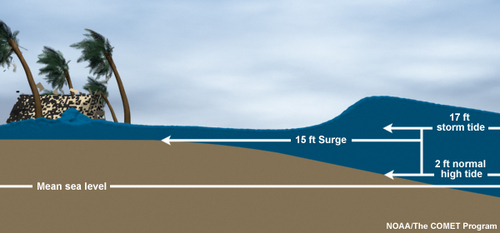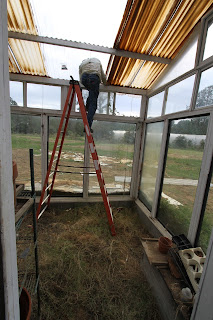Storm Surge Data Released
I checked out Beaufort County data and identified a peak height of the surge on Colleton River at 8.68 feet measured at 7:19AM on October 8, 2016 using an automatic sensor. Another site near Bears Island was measured by the seed line method on October 15, 2016 and revealed a peak surge level of 8.85 feet. To understand how peak surge is calculated, the diagram below shows how normal high tide and storm surge combine to create storm tides.You can access all of the storm surge data at: stn.wim.usgs.gov/fev
Since the data collection efforts are ongoing you can expect to see more data added to this live website over the next two weeks. These peak surge levels are far higher than were anticipated based on the National Weather Service predictions issued the day before the hurricane hit Bluffton, South Carolina.
Flooding on River Systems
The USGS has posted the "water footprint" of Hurricane Matthew at the following website which provides an indication of the storm's impact to river systems along the east coast:https://owi.usgs.gov/vizlab/hurricane-matthew/
The USGS has established a Hurricane Matthew website that includes a whole range of relevant hurricane impact data. The site can be accessed at:
https://www.usgs.gov/special-topic/hurricane-matthew
2016 Hurricane History for South Carolina
To view all of the hurricane and storms that have hit South Carolina this year please access the following NOAA website or see the image below for details.
http://www.nhc.noaa.gov/tafb_latest/tws_atl_latest.gif
Sea Levels Rising from Climate Change
While sea levels along the eastern seaboard are impacted by periodic hurricanes, there is an ongoing small but measurable increase in sea levels every year. Sea levels have risen three (3) inches in the last twenty six (26) years according to data provided by EPA at its climate change indicators website:
Wind Speeds and their Impacts
Wind speeds during hurricane Matthew reached 88 miles per hour at 6:50AM on October 8, 2016 at the Hilton Head airport, a mere 5 miles away from Bears Island. This was the strongest wind measured during hurricane Matthew in South Carolina. You can access measured wind speeds for hurricane Matthew at the National Weather Service website. To determine the potential damage such winds can cause, the Beaufort Scale wind speed impacts is a good reference as shown below.
Force
|
Speed
|
Name
|
Conditions
at Sea |
Conditions
on Land |
||
knots
|
km/h
|
mi/h
|
||||
0
|
<
1
|
<
2
|
<
1
|
Calm
|
Sea like a mirror.
|
Smoke rises vertically.
|
1
|
1-3
|
1-5
|
1-4
|
Light air
|
Ripples only.
|
Smoke drifts and leaves rustle.
|
2
|
4-6
|
6-11
|
5-7
|
Light breeze
|
Small wavelets (0.2 m). Crests
have a glassy appearance.
|
Wind felt on face.
|
3
|
7-10
|
12-19
|
8-11
|
Gentle breeze
|
Large wavelets (0.6 m), crests
begin to break.
|
Flags extended, leaves move.
|
4
|
11-16
|
20-29
|
12-18
|
Moderate breeze
|
Small waves (1 m), some whitecaps.
|
Dust and small branches move.
|
5
|
17-21
|
30-39
|
19-24
|
Fresh breeze
|
Moderate waves (1.8 m), many
whitecaps.
|
Small trees begin to sway.
|
6
|
22-27
|
40-50
|
25-31
|
Strong breeze
|
Large waves (3 m), probably some
spray.
|
Large branches move, wires
whistle, umbrellas are difficult to control.
|
7
|
28-33
|
51-61
|
32-38
|
Near gale
|
Mounting sea (4 m) with foam blown
in streaks downwind.
|
Whole trees in motion,
inconvenience in walking.
|
8
|
34-40
|
62-74
|
39-46
|
Gale
|
Moderately high waves (5.5 m),
crests break into spindrift.
|
Difficult to walk against wind.
Twigs and small branches blown off trees.
|
9
|
41-47
|
76-87
|
47-54
|
Strong gale
|
High waves (7 m), dense foam,
visibility affected.
|
Minor structural damage may occur
(shingles blown off roofs).
|
10
|
48-55
|
88-102
|
55-63
|
Storm
|
Very high waves (9 m), heavy sea
roll, visibility impaired. Surface generally white.
|
Trees uprooted, structural damage
likely.
|
11
|
56-63
|
103-118
|
64-73
|
Violent storm
|
Exceptionally high waves (11 m),
visibility poor.
|
Widespread damage to structures.
|
12
|
64+
|
119+
|
74+
|
Hurricane
|
14 m waves, air filled with foam
and spray, visibility bad.
|
Severe structural damage to
buildings, wide spread devastation.
|
Source: https://www.unc.edu/~rowlett/units/scales/beaufort.html
Rainfall Adds to the Surge and Contributes to Tree Instability
The National Weather service measured 11.07 inches of rain falling on Hilton Head Island from 12 Noon October 7 to 12 Noon October 9, 2016. This deluge of nearly 12 inches of rain contributed to more flooding, higher storm surges and a greater instability to the root systems of trees and shrubs. Detailed data on rainfall from Hurricane Matthew is available from the National Weather Service.
Other Memorable Impacts
Hurricane Matthew caused many other impacts - other than meteorological. For example,
Length of Evacuation: 4 days, 3 hours and 30 minutes (October 5 at 3PM to October 9th at 6:30PM)
Number of Houses without Electricity in South Carolina: 825,000 (as of October 8, 2016). More South Carolinians were without power (as measured as a percentage of the population) than any other state along the eastern seaboard. See chart below.
Source: https://www.eia.gov/todayinenergy/detail.php?id=28372
As of October 17, 2016 at 6PM, SCE&G reported only 190 power outages amongst its 49,264 customers in Beaufort County. Similarly, Palmetto Electric reported that power was restored to the last 32 customers as of 5PM October 15, 2016. At the peak of the hurricane, a total of 61,000 of Palmetto Electric's customers were without power.
Beuafort county was under a 12 hour curfew from 7PM October 7th to 7AM October 8th. This curfew was repeated the night of October 8th.
As of October 17, 2016 at 6PM, SCE&G reported only 190 power outages amongst its 49,264 customers in Beaufort County. Similarly, Palmetto Electric reported that power was restored to the last 32 customers as of 5PM October 15, 2016. At the peak of the hurricane, a total of 61,000 of Palmetto Electric's customers were without power.
Length of Curfew
Beuafort county was under a 12 hour curfew from 7PM October 7th to 7AM October 8th. This curfew was repeated the night of October 8th.











































